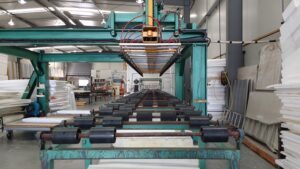
-
The Philippines’ Purchasing Managers’ Index (PMI) rose to 49.9 in November as operating conditions neared stabilization and output levels went up since June
-
The latest reading signaled a movement towards stability and was the highest since September, according to IHS Markit
-
Supply chain disruptions extended into November, with port congestions and traffic delays often linked to steep deterioration in vendor performance
-
Firms’ outlook remained positive but subdued as recent vaccine developments raised hopes for the next year

The Philippine manufacturing sector’s downturn eased considerably in November 2020, as operating conditions inched closer to stabilization and output levels rose for the first time since June.
The Purchasing Managers’ Index (PMI) rose from 48.5 in October to 49.9 in November, posting just below the 50.0 neutral value that separates expansion from contraction, according to the latest survey of IHS Markit.
The latest reading signaled a movement towards stability and was the highest since September.
“The Filipino manufacturing sector showed promising signs of renewed recovery momentum in November as the headline PMI figure neared stabilization. Production rose for the first time since June as foreign demand improved notably from that seen in October,” IHS Markit economist Shreeya Patel said in a statement.
She noted that firms registered the slowest drop in employment in the current nine-month sequence of decline despite a steep depletion in backlogs of work.
“Nevertheless, the path to recovery may not be smooth. The health of the sector rests on the number of COVID-19 cases and the impact the virus has on the global economy. Whilst vaccine developments look promising, it is still unclear when restrictions will come to a complete end,” Patel pointed out.
IHS Markit said production volumes increased fractionally midway through the final quarter of 2020 with the reopening of businesses and a softer reduction in new orders.
Despite a further reduction in new orders, IHS Markit said the overall demand picture improved in November as firms recorded only a fractional contraction in the number of new orders placed and new orders from oversea markets rose moderately, helped by relaxed border restrictions.
The increase in foreign demand was in contrast with the historic series average, indicating stabilization.
Although production levels increased, job shedding persisted at a solid rate as firms had sufficient capacity to meet incoming new orders, and cost saving pressures led to further cuts in workforces.
That said, IHS Markit said the latest fall was the softest in the current period of decline and eased considerably from October.
Further signs of unused capacity at factory plants were reflected in the fourth quickest contraction in backlogs during November.
Back-to-back decreases in new orders led companies to reduce their inventory holdings midway through the fourth quarter. Stocks of both raw materials and finished goods were depleted, which firms linked to uncertain demand conditions and the fulfilment of new orders from existing stock.
But the rate of decline in stocks of finished goods was only fractional as some firms reportedly sought to build inventories.
The current run of supply chain disruptions was extended into November, as signaled by a lengthening in input delivery times in each month since August 2018, IHS Markit said.
Port congestions and traffic delays were often linked to the steep deterioration in vendor performance, it added.
Meanwhile, higher raw material and transportation costs contributed to an increase in total costs.
The rate of inflation was also sharp and the fastest since August. Despite subdued demand conditions, businesses were able to partially pass higher costs onto consumers through a slight increase in selling prices.
IHS Markit said the 12-month outlook for manufacturing production remained positive in November. Recent vaccine developments raised hopes of the passing of the virus over the next year, but the sentiment has moderated since October, and remained subdued.




